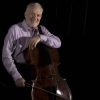- Inseparable, the bow and vibrato together create and shape the contour of the musical phrase
- Bigger sounds need more vibrato width.
- Softer sounds need a narrower vibrato width.
- Vibrato width and vibrato speed are two separate, independent characteristics. Don’t confuse them–master them separately.
- All vibrato (except 1/2 position not discussed in this lesson) is generated by the forearm. To increase or decrease the width or amplitude of your vibrato, enlarge or contract the range of motion of the forearm.
- When playing pianissimo passages, very narrow vibrato may require one to limit the forearm motion. Put the motion right into the fingertip – soften your finger pad and feel lateral flexibility in the pad. In soft dynamics, it is often useful to imagine your finger moving your forearm rather than the other way around. The bow is light on the string and your left hand finger is light as well; do not sink too deep into the fingerboard.
- When playing fortissimo passages, a wide and free vibrato requires maximizing the width of your forearm motion. Imagine your forearm moving your finger. As you vibrate wider, sink more deeply into the fingerboard with your finger pads as a large amplitude must be well anchored to keep from slipping. Avoid over-tightening your bicep muscle; forcing your vibrato can lead to injury.
- Vibrato width and vibrato speed are independent variables. Thus, you have four basic starting points for shaping a phrase with your vibrato: 1) slow and narrow, 2) slow and wide, 3) fast and narrow, and 4) fast and wide. Your musical conceptions of mood, color and dynamic are all inextricably tied to your vibrato.
- Duplicate the video example and practice maintaining one audible vibrato speed while varying the amplitude: Choose a vibrato speed, slow or fast, and keep the audible pulsation constant as you get louder and softer. Begin piano, crescendo with the bow and simultaneously increase the amplitude of the vibrato. Diminuendo to the original dynamic, simultaneously decreasing the amplitude of the vibrato. As you change dynamics, listen that the speed of the vibrato pulsation (slow or fast) doesn’t change. Unify the hands as they sink into the string for crescendo and then lighten in the diminuendo. Goal: When done well, the note gets louder and softer, but the sound of the vibrato doesn’t change.
- “Attach your ear” directly to the sound of your vibrato. Only listening can tell you how wide or how narrow to vibrate; make your ear attentive to varying vibrato amplitudes in response to changing dynamics. It is all too easy (and common) to slip into using one vibrato regardless of the musical context. Ultimately, music requires everything our imaginations can invent, so after the rules are learned they must also be broken.
- Vibrato, when varied, has its own expressive power. It can add layers of complexity and nuance to your interpretation. “Varied” includes moments of pure sound unadorned by vibrato.
About

Paul Katz
Paul Katz is known for his 26-year career as cellist of the internationally acclaimed Cleveland Quartet; as a world-renown teacher…
See MoreCellosophy
"There is as much crescendo or diminuendo in the left hand as there is in the bow. The right and left arms always work together." -Bernard Greenhouse